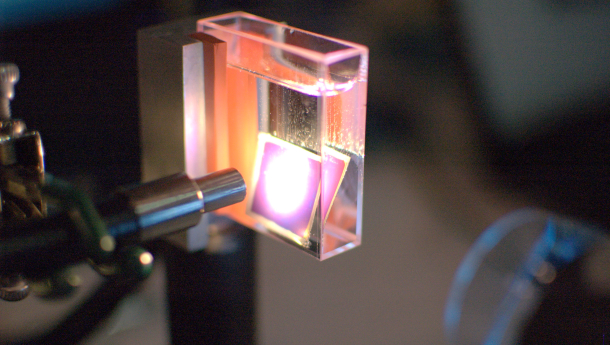forum
library
tutorial
contact

Power Plant: One Small Leaf
Could Electrify an Entire Home
by Richard AdhikariTech News World, March 28, 2011
|
the film forum library tutorial contact |

|
Power Plant: One Small Leaf
by Richard Adhikari |
Scientists at MIT have created what may be the first practical artificial leaf -- a device about the size of a playing card capable of splitting water into hydrogen and oxygen and storing the energy in a fuel cell. Placing the leaf it in a single gallon of water in sunlight could produce enough electricity to supply a house in developing countries with its daily electricity requirement, according to researchers.
 A team of scientists at the Massachusetts Institute of Technology has developed what it describes as the first practical artificial leaf.
A team of scientists at the Massachusetts Institute of Technology has developed what it describes as the first practical artificial leaf.
The device, made from silicon, electronics and catalysts, is the same size and shape as a playing card, but thinner.
It splits water into its two components, hydrogen and oxygen. These are then stored in a fuel cell and used later to generate electricity.
"It's really cool stuff -- they're taking a solar cell and turning it into a battery," Carl Howe, director of anywhere consumer research at the Yankee Group, told TechNewsWorld.
"You can think of this as the first dark solar energy because it'll give you solar energy at night in the form of light," Howe added.
Daniel Nocera, who led the team of scientists that developed the artificial "leaf," was not available for comment at press time.
Soon the World Will Love You, Sweet Leaf
Placing the artificial leaf it in a single gallon of water in bright sunlight could produce enough electricity to supply a house in developing countries with its daily electricity requirement, Nocera has claimed.
Much research has been conducted on the concept of an artificial leaf. Technically, the first artificial leaf was developed more than 10 years ago by John Turner of the U.S. National Renewable Energy Lab in Boulder, Colo.
However, Turner's device used rare, expensive materials and was highly unstable.
Nocera's device uses inexpensive materials that are widely available. It can use water from any source and is highly stable. He has shown that a prototype of his leaf in the laboratory operated continuously for at least 45 hours without a drop in activity.
Nocera has been working on this project for some time. Back in 2008 he worked with postdoctoral fellow Matthew Kanan to develop a process that would use sunlight to split water into hydrogen and oxygen.
The process was based on the researchers' creation of a new catalyst consisting of cobalt, phosphates and an electrode.
When placed in water and electricity from any source is run through the electrode, the catalyst produces oxygen. It is combined with another catalyst such as platinum that can produce hydrogen gas from water, to duplicate photosynthesis.
The conversion of solar energy into hydrogen under ambient conditions is considered to be one of the greatest challenges scientists face in this 21st century.
Scientists believe this process could help create cheap electricity, reduce our dependence on fossil fuels, and thus help mitigate global warming.
Nocera's Work
The technology used in Nocera's latest artificial leaf is based on work done at the Nocera Group.
New catalysts in the Nocera labs self-assemble from water to form a partial cubane structure. They are self-healing, and they split PH-neutral water into hydrogen and oxygen at atmospheric pressure and room temperature.
Cubane is a synthetic hydrocarbon molecule that consists of eight carbon atoms arranged at the corners of a cube with one hydrogen atom attached to each carbon atom.
The catalyst operates at 100mA per square cm at 76 percent efficiency.
"Look at the numbers," the Yankee Group's Howe said. "At 100 mA per square cm, you get a pretty high density, so they're probably getting some good power from the device."
The efficiency of the artificial leaf is also impressive, Howe suggests.
"Overall, solar panels are typically in the 10 percent efficiency range nowadays, so they're not high-efficiency devices," Howe remarked. "If you have something that's able to absorb sunlight at anything close to 70 percent efficiency, it's practically turning sunlight into gold."
The ability to split PH-neutral water has led to the discovery of an inexpensive hydrogen-producing catalyst that operates at 1,000 mA per square cm at 35 mV overpotential.
What all this means is that it could eventually enable the large-scale deployment of solar energy by providing a mechanism for its storage as fuel, the Nocera Group states.
It's a Long, Long Road
The development of Nocera's artificial leaf is a step in the right direction, Jim McGregor, chief technology strategist at In-Stat, told TechNewsWorld.
"This may lead us to larger solutions that let us use thermal, solar and hydrogen solutions all at one time, and that will be huge," McGregor stated.
Relying on solar energy alone is not good enough, McGregor said.
"One of the problems with solar rays is that they heat up the equipment you use excessively," McGregor explained. "After a certain period, the equipment gets so hot that efficiency goes down. So you want to try to mimic nature and create an ecosystem where all these technologies -- thermal, solar and hydrogen -- work together," he said.
learn more on topics covered in the film
see the video
read the script
learn the songs
discussion forum
